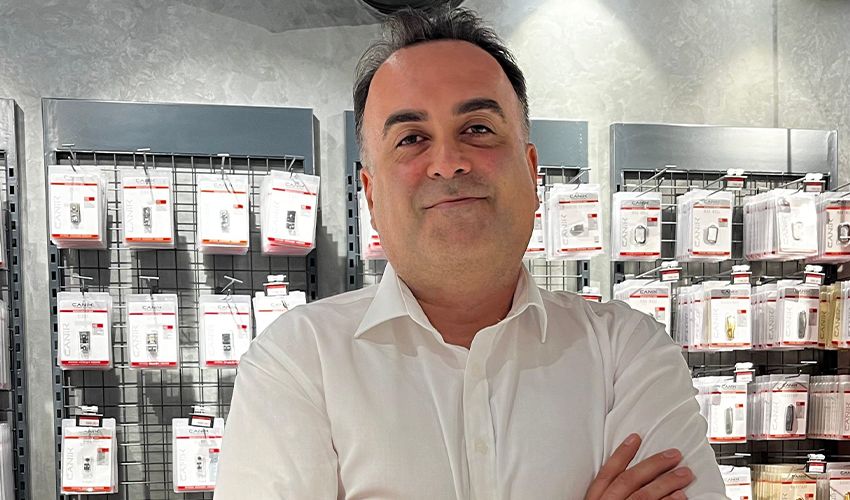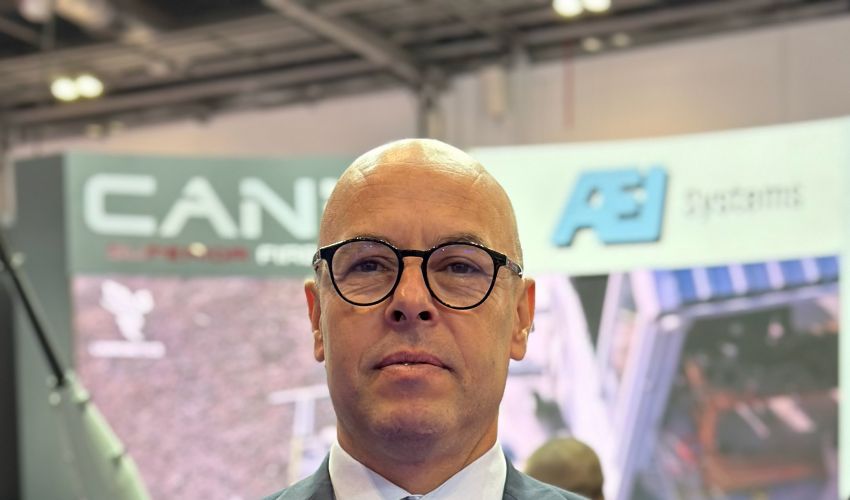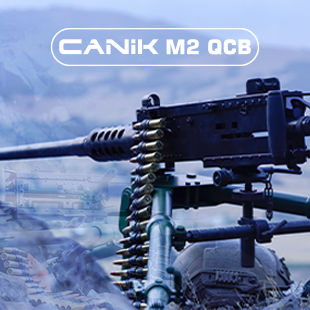CANiK's New Factory "CANiK Facility 4" Challenges the Cookie-Cutter Buildings in the Vicinity
CANiK, the flagship brand of Samsun Yurt Savunma (SYS), is counting down the days until the grand opening of its new factory, 'CANiK Tesis 4' (Facility 4).

CANiK's New Factory "CANiK Facility 4" Challenges the Cookie-Cutter Buildings in the Vicinity
CANiK, the flagship brand of Samsun Yurt Savunma (SYS), is counting down the days until the grand opening of its new factory, 'CANiK Tesis 4' (Facility 4). Located in the Samsun Organized Industrial Zone (OSB), the facility boasts a striking design language and a flexible layout. CANiK’s new facility is a glass cube structure, designed in a rectangular prism shape with a transparent (planar) façade, symbolizing a rebellion against the closed, cookie-cutter designs typical of other buildings in the OSB. The architect behind the project, Pınar Erol, shared the journey of Facility 4’s design process, from the initial concept to its current stage, with CANiK News readers.
CANiK News: Ms. Erol, CANiK is rapidly expanding in the defense and aerospace industry and thanks to its expansion, it is now preparing to launch its 4th facility. Could you tell us about your role in the project and the initial concept stages of the new facility?
Pınar EROL: I led the architectural design team for the project. When I first visited the site where Facility 4 would be located, I felt the presence and scale of the existing building. We needed the existing facilities, yes. Our first step was to create a series of structures that would showcase CANiK's corporate strength and the nature of its work. These were determined based on production capacity and needs. I believe that the architectural design aligns with CANiK's vision and strength, in line with the brand's growth.
CANiK News: Instead of designing and constructing a new building for Facility 4, you chose to repurpose an existing structure. Isn't transforming an existing building more challenging? Can you share the motivation behind this decision?
Pınar EROL: Transforming an existing building might be perceived as more restrictive from an outside perspective, and you’re right in that sense. On the other hand, we had a structure at our disposal, and we actually wanted more—more in every sense. The main theme of the project was not to settle for just one building but to create a concept for other structures as well. I can say that determination, built through professional expertise, played a significant role in this transformation and design. For my team and me, being involved from start to finish in a visionary project that supports production and employment, bringing together all the details like puzzle pieces with experienced craftsmen and artisans, was an extremely enjoyable experience, and I am proud of the work we have done.
CANiK News: What inspired the design plans of the project? What kind of symbolism is embedded in the architecture of the building?
Pınar EROL: Similar to what we did with Facility 1, we adopted an architectural language enriched with details—a language that could be transparent wherever possible, while maintaining the relationship between the interior and exterior. Our goal was to create a large, enclosed, and impactful space that emphasized production and symbolized the entire site. Both the internal and external teams developed a strong interest and sense of responsibility in embracing the architectural language and executing the details, which led to the successful outcome of the project.
CANiK News: In architecture, design and implementation often appear as two separate realities. Every design undergoes some modifications during the implementation phase. How consistent was the design and implementation of this project?
Pınar EROL: As with Facility 1, the design and implementation of this project were very well synchronized. We were experienced in this area. We were prepared for the challenges we might face and the details that might need resolving. We always had a backup plan. The “as built” process, where the final version of the project is modified with revisions done on-site, is something that has happened and will continue to happen in any project. We were able to control these without compromising the architectural language. One can achieve a perfectly satisfactory result in implementation with solution-focused interventions aimed at the overall project and a good team. Our experiences from Facility 1 and the mutual coordination between the design and on-site teams during the project phases were key factors in the success of this project.
CANiK News: Could you describe the technical features of Facility 4?
Pınar EROL: Facility 4 is located in Samsun OSB and was designed on a 9,000-square-meter plot. On this plot, a building with a 4,000 square meter footprint, previously used as a chocolate factory, existed. This building was structurally evaluated, particularly its steel frame and reinforced concrete extensions. We decided to preserve only the steel frame system and the roof covering. Within the existing structure, a new reinforced concrete building was designed for administrative units and shared areas for blue-collar workers. However, the other sections were not as fortunate. Due to the need for greater space and height required for production, a pre-stressed system was chosen. Since the ground-bearing capacity was insufficient, the C and B blocks, along with the glass cube, were reinforced with bored piles before the foundation was laid. We collaborated closely with specialized engineering teams to develop coordinated solutions at this stage.
The technical team determined the positions of the machinery and other areas in line with the needs and requirements of the production processes in the project. Although we sometimes had to make on-site interventions and project revisions to resolve specific details, we ensured that the architectural design principles were upheld without any compromises. We did all this while the building required a complex mechanical network, and we applied all the correct principles in our processes. From the beginning of the design phase, Facility 4 was conceived with both architectural and engineering considerations in mind, allowing for a degree of flexibility.
CANiK News: What does the overall picture look like when we consider the construction activities of CANiK over the past four years?
Pınar EROL: Let's start with Facility 1, with its renovation and additional units, which cover 8,450 square meters of enclosed space on a 7,500 square meter plot, currently housing the administrative units. Additionally, Facility 3, which was completed almost simultaneously, spans 8,000 square meters. Facility 2 occupies 3,600 square meters. Currently under construction, Facility 4 will have 11,000 square meters of enclosed space on a 9,000 square meter plot. Upon completion of Facility 4, we will have a total of 31,050 square meters of enclosed space on 28,100 square meters of land in Samsun OSB.
CANiK News: How did the design of Facility 4 align with CANiK's vision?
Pınar EROL: We preserved the characteristic feature of the facade cladding from the old structure in the new design, developing a series of striking design strategies for the existing building. The design needed to reflect CANiK’s future goals, boldness, seriousness, and vision. All units were interconnected with bridges or connecting corridors. The entire concept was further supported by well-defined common areas and landscaping. The rectangular prism-shaped glass cube, created using a transparent facade and connecting the two main structures, was designed as a rebellion against the closed and cookie-cutter buildings and attitudes prevalent in the OSB. In production-focused projects like this, I find it more rational to approach solutions through a series of structures. Using clearly defined areas and building transitions between them is much more logical and enriching rather than using a single shell. As I mentioned earlier, the resulting architectural design is a reflection of CANiK's vision and strength, paralleling its growth.
We would like to thank Architect Pınar Erol for taking the time to answer our questions, and for providing us with such valuable information.
CANiK, the flagship brand of Samsun Yurt Savunma (SYS), is counting down the days until the grand opening of its new factory, 'CANiK Tesis 4' (Facility 4). Located in the Samsun Organized Industrial Zone (OSB), the facility boasts a striking design language and a flexible layout. CANiK’s new facility is a glass cube structure, designed in a rectangular prism shape with a transparent (planar) façade, symbolizing a rebellion against the closed, cookie-cutter designs typical of other buildings in the OSB. The architect behind the project, Pınar Erol, shared the journey of Facility 4’s design process, from the initial concept to its current stage, with CANiK News readers.
CANiK News: Ms. Erol, CANiK is rapidly expanding in the defense and aerospace industry and thanks to its expansion, it is now preparing to launch its 4th facility. Could you tell us about your role in the project and the initial concept stages of the new facility?
Pınar EROL: I led the architectural design team for the project. When I first visited the site where Facility 4 would be located, I felt the presence and scale of the existing building. We needed the existing facilities, yes. Our first step was to create a series of structures that would showcase CANiK's corporate strength and the nature of its work. These were determined based on production capacity and needs. I believe that the architectural design aligns with CANiK's vision and strength, in line with the brand's growth.
CANiK News: Instead of designing and constructing a new building for Facility 4, you chose to repurpose an existing structure. Isn't transforming an existing building more challenging? Can you share the motivation behind this decision?
Pınar EROL: Transforming an existing building might be perceived as more restrictive from an outside perspective, and you’re right in that sense. On the other hand, we had a structure at our disposal, and we actually wanted more—more in every sense. The main theme of the project was not to settle for just one building but to create a concept for other structures as well. I can say that determination, built through professional expertise, played a significant role in this transformation and design. For my team and me, being involved from start to finish in a visionary project that supports production and employment, bringing together all the details like puzzle pieces with experienced craftsmen and artisans, was an extremely enjoyable experience, and I am proud of the work we have done.
CANiK News: What inspired the design plans of the project? What kind of symbolism is embedded in the architecture of the building?
Pınar EROL: Similar to what we did with Facility 1, we adopted an architectural language enriched with details—a language that could be transparent wherever possible, while maintaining the relationship between the interior and exterior. Our goal was to create a large, enclosed, and impactful space that emphasized production and symbolized the entire site. Both the internal and external teams developed a strong interest and sense of responsibility in embracing the architectural language and executing the details, which led to the successful outcome of the project.
CANiK News: In architecture, design and implementation often appear as two separate realities. Every design undergoes some modifications during the implementation phase. How consistent was the design and implementation of this project?
Pınar EROL: As with Facility 1, the design and implementation of this project were very well synchronized. We were experienced in this area. We were prepared for the challenges we might face and the details that might need resolving. We always had a backup plan. The “as built” process, where the final version of the project is modified with revisions done on-site, is something that has happened and will continue to happen in any project. We were able to control these without compromising the architectural language. One can achieve a perfectly satisfactory result in implementation with solution-focused interventions aimed at the overall project and a good team. Our experiences from Facility 1 and the mutual coordination between the design and on-site teams during the project phases were key factors in the success of this project.
CANiK News: Could you describe the technical features of Facility 4?
Pınar EROL: Facility 4 is located in Samsun OSB and was designed on a 9,000-square-meter plot. On this plot, a building with a 4,000 square meter footprint, previously used as a chocolate factory, existed. This building was structurally evaluated, particularly its steel frame and reinforced concrete extensions. We decided to preserve only the steel frame system and the roof covering. Within the existing structure, a new reinforced concrete building was designed for administrative units and shared areas for blue-collar workers. However, the other sections were not as fortunate. Due to the need for greater space and height required for production, a pre-stressed system was chosen. Since the ground-bearing capacity was insufficient, the C and B blocks, along with the glass cube, were reinforced with bored piles before the foundation was laid. We collaborated closely with specialized engineering teams to develop coordinated solutions at this stage.
The technical team determined the positions of the machinery and other areas in line with the needs and requirements of the production processes in the project. Although we sometimes had to make on-site interventions and project revisions to resolve specific details, we ensured that the architectural design principles were upheld without any compromises. We did all this while the building required a complex mechanical network, and we applied all the correct principles in our processes. From the beginning of the design phase, Facility 4 was conceived with both architectural and engineering considerations in mind, allowing for a degree of flexibility.
CANiK News: What does the overall picture look like when we consider the construction activities of CANiK over the past four years?
Pınar EROL: Let's start with Facility 1, with its renovation and additional units, which cover 8,450 square meters of enclosed space on a 7,500 square meter plot, currently housing the administrative units. Additionally, Facility 3, which was completed almost simultaneously, spans 8,000 square meters. Facility 2 occupies 3,600 square meters. Currently under construction, Facility 4 will have 11,000 square meters of enclosed space on a 9,000 square meter plot. Upon completion of Facility 4, we will have a total of 31,050 square meters of enclosed space on 28,100 square meters of land in Samsun OSB.
CANiK News: How did the design of Facility 4 align with CANiK's vision?
Pınar EROL: We preserved the characteristic feature of the facade cladding from the old structure in the new design, developing a series of striking design strategies for the existing building. The design needed to reflect CANiK’s future goals, boldness, seriousness, and vision. All units were interconnected with bridges or connecting corridors. The entire concept was further supported by well-defined common areas and landscaping. The rectangular prism-shaped glass cube, created using a transparent facade and connecting the two main structures, was designed as a rebellion against the closed and cookie-cutter buildings and attitudes prevalent in the OSB. In production-focused projects like this, I find it more rational to approach solutions through a series of structures. Using clearly defined areas and building transitions between them is much more logical and enriching rather than using a single shell. As I mentioned earlier, the resulting architectural design is a reflection of CANiK's vision and strength, paralleling its growth.
We would like to thank Architect Pınar Erol for taking the time to answer our questions, and for providing us with such valuable information.





